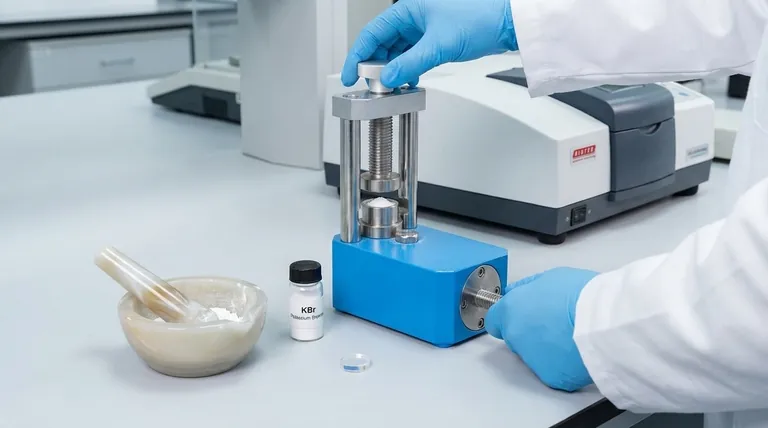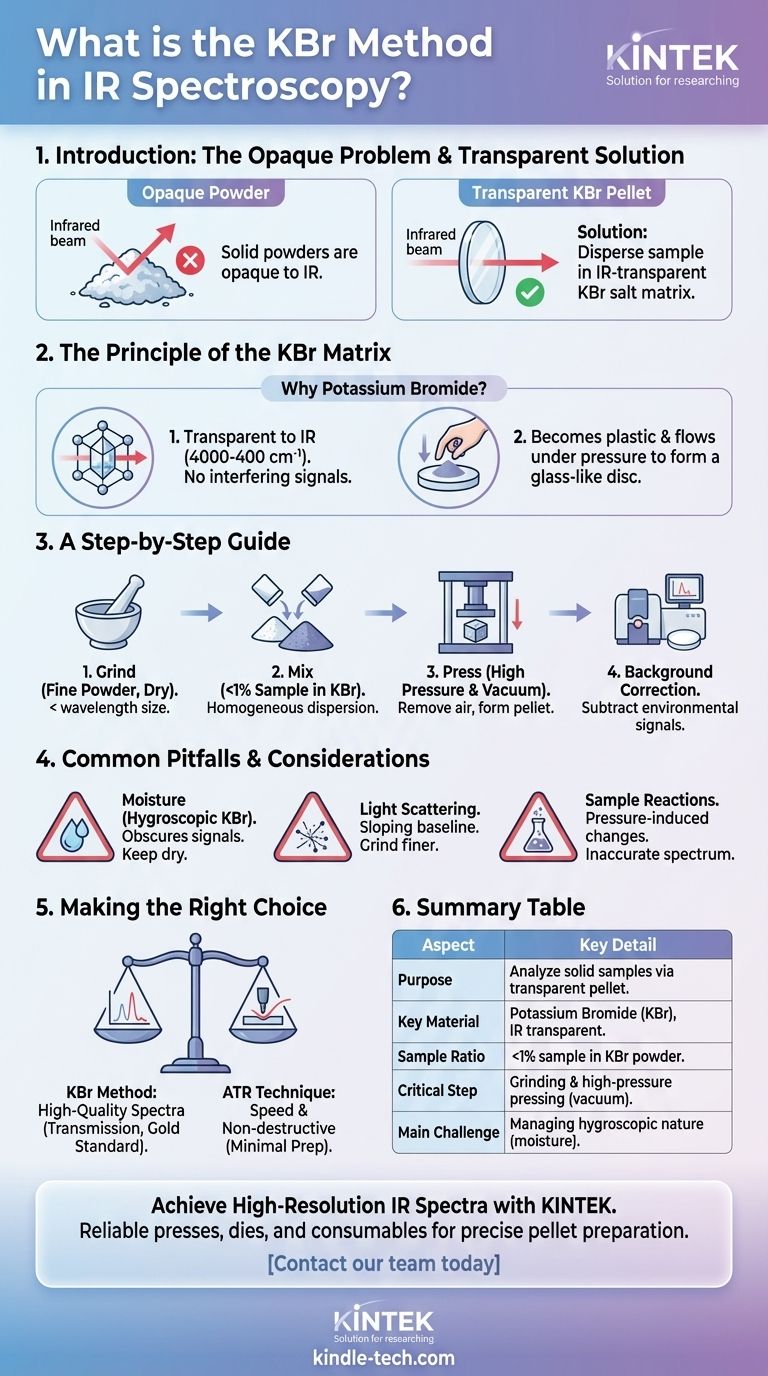적외선(IR) 분광법에서, KBr 방법은 고체 물질을 분석하는 데 사용되는 시료 준비 기술입니다. 이는 소량의 시료를 브롬화칼륨(KBr) 분말과 함께 미세하게 분쇄하고, 혼합물을 고압으로 압축하여 얇고 투명한 펠릿을 형성하는 과정을 포함합니다. 이 펠릿은 분석을 위해 분광계의 적외선 빔 경로에 직접 놓을 수 있습니다.
IR 분광법으로 고체 분말을 분석하는 핵심 과제는 일반적으로 불투명하다는 것입니다. KBr 방법은 시료를 IR 투과성 염 매트릭스 내에 분산시켜 이 문제를 해결하며, 효과적으로 분말을 적외선이 통과할 수 있는 "창"으로 만듭니다.

KBr 매트릭스의 원리
왜 브롬화칼륨인가요?
브롬화칼륨(KBr)은 두 가지 중요한 이유로 이 기술의 표준 선택입니다. 첫째, 가장 일반적인 분석 범위(4000-400 cm⁻¹)에서 적외선 복사에 투명하여 자체적으로 간섭 신호를 생성하지 않습니다.
둘째, KBr 및 기타 알칼리 할로겐화물은 엄청난 압력 하에서 가소성이 되어 흐르는 독특한 특성을 가지고 있습니다. 이 특성 덕분에 미세한 분말이 서로 융합하여 시료를 제자리에 고정하는 단단하고 유리 같은 디스크를 형성할 수 있습니다.
목표: 균일한 분산
이 방법의 궁극적인 목표는 시료의 미세 입자가 KBr 매트릭스 전체에 균일하고 얇게 분산된 펠릿을 만드는 것입니다.
적절한 분산은 빛 산란을 최소화하고 적외선 빔이 대표적인 양의 시료와 상호 작용하여 명확하고 정확한 스펙트럼을 얻도록 보장합니다.
방법에 대한 단계별 가이드
1단계: 시료 분쇄
시료와 KBr 모두 극도로 건조하고 미세하게 분쇄되어야 좋은 결과를 얻을 수 있습니다. 일반적으로 마노 유발과 유봉을 사용하여 시료를 IR 복사 파장보다 작은 입자 크기의 분말로 분쇄하여 산란을 줄입니다.
2단계: 혼합
아주 소량의 분쇄된 시료(일반적으로 1% 미만)를 더 많은 양의 건조 KBr 분말에 첨가합니다. 두 가지를 철저히 혼합하고 분쇄하여 시료가 균일하게 분산되도록 합니다.
3단계: 펠릿 압착
혼합물을 다이에 넣고 유압 프레스에 넣습니다. 종종 다이에 진공을 가하여 갇힌 공기와 수분을 제거하는데, 이는 펠릿을 불투명하게 만들거나 스펙트럼 간섭을 유발할 수 있습니다.
프레스는 수 톤의 힘을 가하여 KBr이 가소화되어 시료를 포함하는 투명한 펠릿을 형성하게 합니다.
4단계: 배경 보정
시료를 분석하기 전에 배경 스펙트럼을 측정합니다. 이는 빈 펠릿 홀더로 수행할 수 있으며, 이상적으로는 순수 KBr로 만든 "빈" 펠릿으로 수행할 수 있습니다. 이 단계는 기기 소프트웨어가 대기 중 CO₂, 수증기 또는 KBr 자체의 불순물로 인한 모든 신호를 빼도록 합니다.
일반적인 함정과 고려 사항
수분 문제
KBr은 흡습성이 강하여 대기 중의 수분을 쉽게 흡수합니다. 물은 적외선 스펙트럼에서 매우 강한 흡수 띠를 가지고 있어 시료의 중요한 신호를 쉽게 가릴 수 있습니다.
KBr 분말과 시료를 포함한 모든 장비는 철저히 건조하게 유지되어야 하며, 종종 오븐이나 데시케이터에 보관됩니다.
빛 산란 효과
시료 입자가 충분히 미세하게 분쇄되지 않으면 적외선 빔을 흡수하는 대신 산란시킵니다. 이는 기울어진 기준선과 감소된 신호 강도로 인해 품질이 낮은 스펙트럼을 초래하여 해석을 어렵게 만듭니다.
시료 반응 가능성
펠릿을 형성하는 데 사용되는 고압은 때때로 시료에 화학적 또는 물리적 변화를 유도할 수 있습니다. 특정 화합물은 KBr 자체와 반응하여 원래 물질을 나타내지 않는 부정확한 스펙트럼을 초래할 수 있습니다.
목표에 맞는 올바른 선택
KBr 방법은 강력하고 고전적인 기술이지만, 현대적인 대안도 존재합니다. 선택은 전적으로 분석 요구 사항에 따라 달라집니다.
- 고품질, 고해상도 스펙트럼에 중점을 둔다면: KBr 방법은 신중하게 실행될 경우 고체 투과 측정의 황금 표준입니다.
- 속도와 비파괴 분석에 중점을 둔다면: ATR(감쇠 전반사)과 같은 기술은 시료 준비가 거의 필요 없으므로 종종 더 우수합니다.
- 시료가 수분이나 압력에 민감하다면: KBr 방법을 사용할 때 극도의 주의를 기울이거나 인공물을 피하기 위해 대체 기술을 선택해야 합니다.
KBr 방법의 원리를 이해하면 고체 시료에서 깨끗하고 신뢰할 수 있는 스펙트럼 데이터를 생성할 수 있습니다.
요약 표:
| 측면 | 주요 세부 사항 |
|---|---|
| 목적 | IR 분광법에서 고체 시료를 투명한 펠릿으로 만들어 분석합니다. |
| 핵심 재료 | 브롬화칼륨(KBr), IR 빛에 투명합니다. |
| 시료 비율 | 일반적으로 KBr 분말에 분산된 시료가 1% 미만입니다. |
| 중요 단계 | 미세 분말로 분쇄하고 진공 상태에서 고압을 가합니다. |
| 주요 과제 | 수분 간섭을 피하기 위해 KBr의 흡습성 특성을 관리합니다. |
고체 시료에서 고해상도 IR 스펙트럼을 얻을 준비가 되셨나요? KBr 방법은 기본적인 기술이며, 성공을 위해서는 올바른 장비가 중요합니다. KINTEK은 정밀한 펠릿 준비를 위한 신뢰할 수 있는 실험실 프레스, 다이 및 소모품을 전문적으로 제공합니다.
저희 전문가들은 수분 문제를 최소화하고 명확하고 정확한 결과를 위한 균일한 펠릿을 보장하는 완벽한 도구를 선택하는 데 도움을 드릴 수 있습니다.
오늘 저희 팀에 연락하여 실험실의 요구 사항을 논의하고 IR 분광법 기능을 향상시키세요!
시각적 가이드

관련 제품
- kbr 펠렛 프레스 2t
- 실험실 유압 프레스 분리형 전기 실험실 펠렛 프레스
- XRF 및 KBR 펠렛 프레스용 자동 실험실 유압 프레스
- FTIR용 XRF & KBR 스틸 링 실험실 분말 펠릿 프레스 몰드
- 실험실용 자동 유압 펠렛 프레스 기계



















